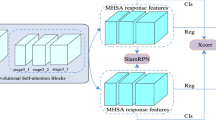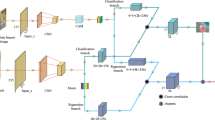Abstract
With the lightweight and dexterous design, unmanned aerial vehicles (UAVs) are widely used to perform near-surface target detection missions in various complex environments. The camouflaged personnel detection in the images captured by the UAVs plays an essential role in the information acquisition, which determines the success of detection missions. However, the camouflaged personnel are not easily discovered due to the high similarity between the camouflage style and the background. In addition, there is only available few labeled sample images. To address above-mentioned problems, a camouflaged personnel dataset is first established, and a novel anchor-based method is then proposed to detect the camouflaged personnel. In addition, the efficient channel attention and the improved receptive fields block are added in the anchor-based convolutional network to focus on more features about the camouflaged targets. Besides, the non-maximum suppression is applied to determine the optimal bounding box on the targets. The quantitative results and visualization effects demonstrate that the mean average precision of the proposed method can reach 85%, and the recall can reach 83% on the developed dataset.












Similar content being viewed by others
Data availability
The dataset generated during the current study are not publicly available but is available from the corresponding author on reasonable request.
References
Liu, Y., Liao, L., Wu, H., Qin, J., He, L., Yang, G., Zhang, H., Zhang, J.: Trajectory and image-based detection and identification of UAV. Vis. Comput. 37, 1769–1780 (2021). https://doi.org/10.1007/s00371-020-01937-y
Gong, K., Cao, Z., Xiao, Y., Fang, Z.: Abrupt-motion-aware lightweight visual tracking for unmanned aerial vehicles. Vis. Comput. 37, 371–383 (2021). https://doi.org/10.1007/s00371-020-01805-9
Fan, J.R., Li, D.G., Li, R.P., Wang, Y.: Analysis on MAV/UAV cooperative combat based on complex network. Def. Technol. 16(1), 150–157 (2020). https://doi.org/10.1016/j.dt.2019.09.002
Fan, J., Yang, X., Lu, R., Li, W., Huang, Y.: Long-term visual tracking algorithm for UAVs based on kernel correlation filtering and SURF features. Vis. Comput. (2022). https://doi.org/10.1007/s00371-021-02331-y
Yang, X., Xu, W.D., Jia, Q., Liu, J.: MF-CFI: a fused evaluation index for camouflage patterns based on human visual perception. Def. Technol. (2021). https://doi.org/10.1016/j.dt.2020.08.007
Zheng, Y., Zhang, X., Wang, F., Cao, T., Sun, M., Wang, X.: Detection of people with camouflage pattern via dense deconvolution network. IEEE Signal Process. Lett. 1, 29–33 (2019). https://doi.org/10.1109/LSP.2018.2825959
Zhu, Q.: ACDNet with ASPP for camouflaged object detection. J. Phys. Conf. Ser. (2021). https://doi.org/10.1088/1742-6596/1982/1/012082
Liu, Y., Yang, F., Ginhac, D.: ACDnet: An action detection network for real-time edge computing based on flow-guided feature approximation and memory aggregation. Pattern Recognit. Lett. 145, 18–126 (2021). https://doi.org/10.1016/j.patrec.2021.02.001
Liu, Y., Wang, C.Q., Zhou, Y.J.: Camouflaged people detection based on a semi-supervised search identification network. Def. Technol. (2022). https://doi.org/10.1016/j.dt.2021.09.004
Roy, K., Sahay, R.R.: A robust multi-scale deep learning approach for unconstrained hand detection aided by skin segmentation. Vis. Comput. (2021). https://doi.org/10.1007/s00371-021-02157-8
Girshick, R., Donahue, J., Darrell, T., Malik, J.: Rich feature hierarchies for accurate object detection and semantic segmentation. In: Proceedings of the IEEE Computer Society Conference on Computer Vision and Pattern Recognition 580–587(2014) https://doi.org/10.1109/CVPR.2014.81
Yuan, W., Fu, C., Liu, R., et al.: SSoB: searching a scene-oriented architecture for underwater object detection. Vis. Comput. (2022). https://doi.org/10.1007/s00371-022-02654-4
Junos, M.H., Mohd Khairuddin, A.S., Thannirmalai, S., Dahari, M.: Automatic detection of oil palm fruits from UAV images using an improved YOLO model. Vis. Comput. (2021). https://doi.org/10.1007/s00371-021-02116-3
Chen, W., Huang, H., Peng, S., Zhou, C., Zhang, C.: YOLO-face: a real-time face detector. Vis. Comput. 37, 805–813 (2021). https://doi.org/10.1007/s00371-020-01831-7
Zeng, L., Duan, X., Pan, Y., et al.: Research on the algorithm of helmet-wearing detection based on the optimized yolov4. Vis. Comput. (2022). https://doi.org/10.1007/s00371-022-02471-9
Fan, D.P., Ji, G.P., Sun, G., Cheng, M.M., Shen, J., Shao, L.: Camouflaged object detection. In: Proceedings of the IEEE Computer Society Conference on Computer Vision and Pattern Recognition (2020) https://doi.org/10.1109/CVPR42600.2020.00285
Le, T.N., Nguyen, T.V., Nie, Z., Tran, M.T., Sugimoto, A.: Anabranch network for camouflaged object segmentation. Comput. Vis. Image Underst. (2019). https://doi.org/10.1016/j.cviu.2019.04.006
Boult, T.E., Micheals, R.J., Gao, X., Eckmann, M.: Into the woods: Visual surveillance of noncooperative and camouflaged targets in complex outdoor settings. Proc. IEEE. 89(10), 1382–1402 (2001). https://doi.org/10.1109/5.959337
Chen, J.Y.C.: UAV-guided navigation for ground robot tele-operation in a military reconnaissance environment. Ergonomics 8, 940–950 (2010). https://doi.org/10.1080/00140139.2010.500404
Daoudi, S., Zouaoui, C.M.A., El-Mezouar, M.C., Taleb, N.: Parallelization of the K-Means++ clustering algorithm. Ing. Des Syst. Inf. 26(1), 59–66 (2021). https://doi.org/10.18280/isi.260106
Liu, S., Huang, D., Wang, Y.: Receptive Field Block Net for Accurate and Fast Object Detection. In: Lecture Notes in Computer Science (including subseries Lecture Notes in Artificial Intelligence and Lecture Notes in Bioinformatics) 404–419 (2018). https://doi.org/10.1007/978-3-030-01252-6_24
Hu, J., Shen, L., Albanie, S., Sun, G., Wu, E.: Squeeze-and-excitation networks. IEEE Trans. Pattern Anal. Mach. Intell. 42(8), 2011–2023 (2020). https://doi.org/10.1109/TPAMI.2019.2913372
Wang, Q., Wu, B., Zhu, P., Li, P., Zuo, W., Hu, Q.: ECA-Net: Efficient channel attention for deep convolutional neural networks. In: Proceedings of the IEEE Computer Society Conference on Computer Vision and Pattern Recognition (2020) https://doi.org/10.1109/CVPR42600.2020.01155
Zheng, Z., Wang, P., Liu, W., Li, J., Ye, R., Ren, D.: Distance-IoU loss: faster and better learning for bounding box regression. In: AAAI 2020 - 34th AAAI Conference on Artificial Intelligence (2020) https://doi.org/10.1609/aaai.v34i07.6999
Liu, W., Anguelov, D., Erhan, D., Szegedy, C., Reed, S., Fu, C.Y., Berg, A.C.: SSD: single shot multibox detector. In: Lecture Notes in Computer Science (including subseries Lecture Notes in Artificial Intelligence and Lecture Notes in Bioinformatics) 21–37(2016). https://doi.org/10.1007/978-3-319-46448-0_2
Lin, T.Y., Goyal, P., Girshick, R., He, K., Dollar, P.: Focal loss for dense object detection. In: Proceedings of the IEEE International Conference on Computer Vision 42(2), 318–327 (2017). https://doi.org/10.1109/ICCV.2017.324
Zhou, X., Austin, U.T., Wang, D., Berkeley, U.C., Austin, U.T.: Object as point. Cvpr (2019). https://doi.org/10.48550/arXiv.1904.07850
Wang, C.Y., Bochkovskiy, A., Liao, H.Y.M.: Scaled-yolov4: scaling cross stage partial network. In: Proceedings of the IEEE Computer Society Conference on Computer Vision and Pattern Recognition (2021). https://doi.org/10.48550/arXiv.2011.08036
Sun, P., Zhang, R., Jiang, Y., Kong, T., Xu, C., Zhan, W., Tomizuka, M., Li, L., Yuan, Z., Wang, C., Luo, P.: Sparse R-CNN: end-to-end object detection with learnable proposals. In: Proceedings of the IEEE Computer Society Conference on Computer Vision and Pattern Recognition (2021) https://doi.org/10.48550/arXiv.2011.12450
Zhang, H., Wang, Y., Dayoub, F., Sünderhauf, N.: VarifocalNet: an IoU-aware Dense Object Detector. In: Proceedings of the IEEE Computer Society Conference on Computer Vision and Pattern Recognition (2021)
Kong, T., Sun, F., Liu, H., Jiang, Y., Shi, J.: FoveaBox: beyond anchor-based object detector. Proc. IEEE Comput. Soc. Conf. Comput. Vis. Pattern Recognit (2019). https://doi.org/10.48550/arXiv.1904.03797
Zhu B.J., Wang J.F., Jiang Z.K., Zong F.H., Liu S.T., Li Z.M., Sun J.: AutoAssign: differentiable label assignment for dense object detection. In: Proceedings of the IEEE Computer Society Conference on Computer Vision and Pattern Recognition (2020) https://doi.org/10.48550/arXiv.2007.03496
Acknowledgements
The work described in this paper was partially supported by the Project of Science and Technology on Near-Surface Detection Laboratory of China (Grant No. TCGZ2019A006).
Author information
Authors and Affiliations
Corresponding author
Ethics declarations
Conflict of interest
All authors certify that they have no affiliations with or involvement in any organization or entity with any financial interest or non-financial interest in the subject matter or materials discussed in this manuscript.
Additional information
Publisher's Note
Springer Nature remains neutral with regard to jurisdictional claims in published maps and institutional affiliations.
Rights and permissions
Springer Nature or its licensor (e.g. a society or other partner) holds exclusive rights to this article under a publishing agreement with the author(s) or other rightsholder(s); author self-archiving of the accepted manuscript version of this article is solely governed by the terms of such publishing agreement and applicable law.
About this article
Cite this article
Xu, B., Wang, C., Liu, Y. et al. An anchor-based convolutional network for the near-surface camouflaged personnel detection of UAVs. Vis Comput 40, 1659–1671 (2024). https://doi.org/10.1007/s00371-023-02877-z
Accepted:
Published:
Issue Date:
DOI: https://doi.org/10.1007/s00371-023-02877-z




